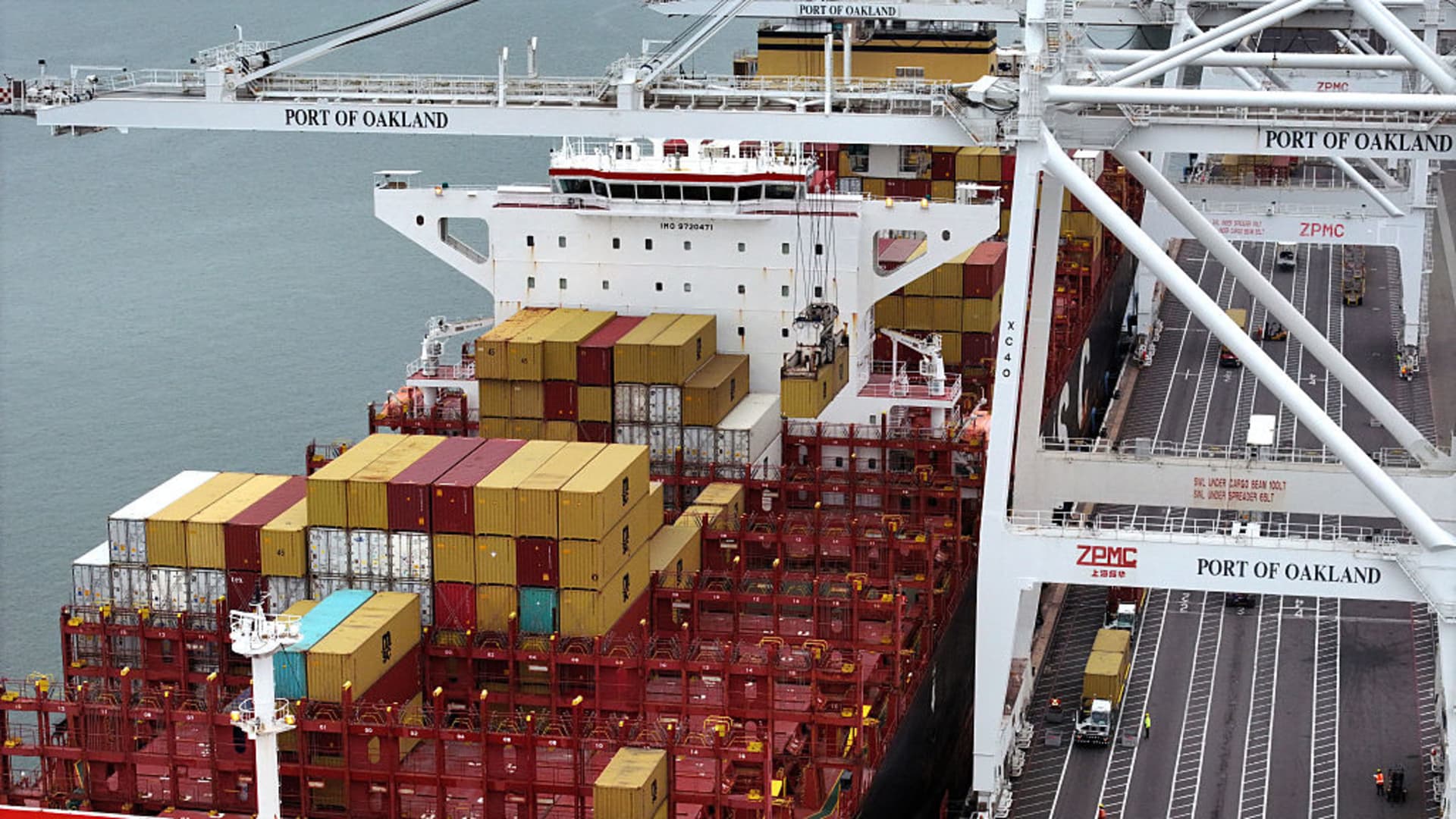Justin Sullivan | Getty Images
Recent data on container volumes shows that while the nation’s busiest port, Los Angeles, has seen a sizable bump in traffic, that has come at the expense of trade activity for smaller ports, where there has been a reduction in scheduled services for imports, according to ITS Logistics’ monthly US Port/Rail Ramp Freight Index.
“The ports of Oakland, Jacksonville, New Orleans, and Panama City [Florida] are getting sandwiched out of port calls as more shippers decide to unload their freight in the larger ports in an effort to get the product in before the tariffs,” said Paul Brashier, vice president of global supply chain at ITS Logistics.
The Port of Oakland recently reported a 10.1% decrease month-over-month in June — year-over-year container traffic was down 13%.
Port of Oakland maritime director Bryan Brandes said the softening demand is a result of the ongoing tariff uncertainty. “This is not a seasonal dip, but a market recalibration,” said Brandes. “Importers and exporters are adjusting their supply chain timing and routing decisions in response to evolving conditions,” he added.
Oakland is unique among U.S. ports, maintaining a near 50/50 balance of imports and exports, with a big role in the nation’s agricultural trade. The Port of Oakland is the No. 1 refrigerated export gateway in the U.S., and nearly all containerized cargo moving through Northern California goes through the Port of Oakland.
Container volumes are key economic and job drivers for a port’s local community and economic stability, and port officials have voiced concerns in recent months about the trade war risks. The Port of Oakland, along with its partners, supports more than 98,000 regional jobs and $174 billion in annual economic activity.
Jobs and trade have also been a focal point for the larger ports, even amid a short-term increase in container volumes during the pause on the steepest Chinese tariff levels, which saw the Port of Los Angeles handle record monthly traffic in June.
Back in its May container update, Port of LA executive director Gene Seroka said the drop in containers being moved impacted jobs. “We saw that for every two longshore members that walked into the hiring hall, one went home without work,” he said.
During the more recent front-loading of Chinese goods ahead of the mid-August deadline for a trade deal before much higher tariffs kick in, port officials have stressed that they would not describe it as a “surge.”
Seroka recently told CNBC that “shifting timelines simply mean shifting volume and more uncertainty here at the Port of LA. Looking into August, if everything holds the way we see it right now, I expect volume to ease because of those new tariffs being in place, making it more costly for American importers.”
Smaller ports will continue to face economic pain
“It’s easy to say right now, peak season is earlier than normal. Just a question of how long this will last,” Brashier said. He added that the recent trend among ocean carriers to concentrate on the largest ports like Los Angeles while skipping secondary ports like the Port of Oakland should continue.
“There is too much uncertainty in the marketplace right now for companies to truly book ahead,” he said. “Companies are reassigning their logistics to be as efficient as possible in moving their decreased number of containers. It is all about margins, so when you are negotiating with logistics companies, shippers may have more negotiating power with more containers arriving at one port instead of two or three.”
Comparing June and July container arrivals, the majority of the secondary ports across the U.S. are down substantially, according to trade tracker Vizion, though Oakland has seen a slight turnaround.
- USMOB (Mobile): +3,154 TEUs (+7.04%)
- USOAK (Oakland): +1,183 TEUs (+1.10%)
- USJAX (Jacksonville): -3,803 TEUs (−12.90%)
- USCHS (Charleston): -21,339 TEUs (−13.37%)
- USBAL (Baltimore): -14,815 TEUs (−17.65%)
- USMSY (New Orleans): -10,657 TEUs (−34.92%)
- USSEA (Seattle): -65,705 TEUs (−35.75%)
- USTIW (Tacoma): -60,311 TEUs (−36.01%)
Josh Stein, governor of North Carolina, recently told CNBC that there has been a recent reduction in traffic at the state’s biggest port in Wilmington, a result of trade policy that “changes practically on a daily basis.”
“We need to have stability, businesses need certainty, so they can figure out how and where to invest,” Stein said. More than 20% of North Carolina’s GDP in 2024 came from international trade in goods, according to data from Trade Partnership Worldwide.
The outlook for Chinese exports to the U.S., according to recent SONAR data on ocean freight bookings, suggests a decline in orders headed to the U.S. in the coming weeks.
Even as the stock market and economy prove resilient in the face of tariff uncertainty, U.S. companies continue to downsize orders or eliminate products that are not as popular.
“Carriers are aligning service schedules, resulting in fewer sailings, fuller ships, and volume patterns that mirror the broader hesitancy in global trade,” said Brashier.
There are economic reasons for shippers to maintain service across a wide portfolio of ports. Brashier said the decision to cut down on ports called on can negatively lead to higher costs. Export containers can be in different locations, which can impact availability, and truck transportation costs can be anywhere between two and four times what is typical.
“Normally, a company’s distribution center is near the port where they traditionally bring their freight in,” Brashier said. “If their containers are now being offloaded at another port, that means that container pickup, which was originally a local pickup, could morph into a 400 to 500-mile trucking job. The more miles a trucker travels to pick up a container and return, the more expensive that freight move will be.”
















Leave a Reply